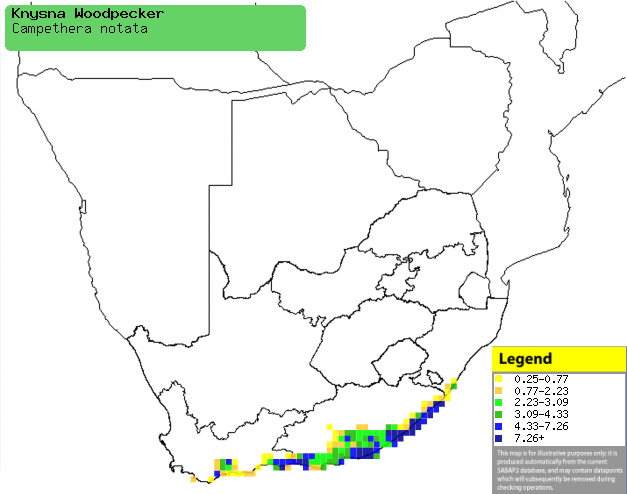|
Campethera notata (Knysna
woodpecker)
Knysnaspeg [Afrikaans]; Isinqolamthi (also applied to
Cardinal woodpecker) [Xhosa]; Knysna-specht [Dutch]; Pic tigré [French];
Natalspecht [German]; Pica-pau de Knysna [Portuguese]
Life > Eukaryotes > Opisthokonta > Metazoa (animals) > Bilateria > Deuterostomia > Chordata > Craniata > Vertebrata (vertebrates) > Gnathostomata (jawed vertebrates) > Teleostomi (teleost fish) > Osteichthyes (bony fish) > Class: Sarcopterygii (lobe-finned fish) > Stegocephalia (terrestrial vertebrates) > Tetrapoda (four-legged vertebrates) > Reptiliomorpha > Amniota > Reptilia (reptiles) > Romeriida > Diapsida > Archosauromorpha > Archosauria > Dinosauria (dinosaurs) > Saurischia > Theropoda (bipedal predatory dinosaurs) > Coelurosauria > Maniraptora > Aves (birds) > Order: Piciformes > Family: Picidae
The Knysna woodpecker is endemic to South Africa, being found
in woodlands and thickets along the southern coastline. It mainly forages in
trees, searching dead branches for invertebrates and gleaning ants from branch
and leaves. Both sexes excavate the nest, which is usually a hole in the
underside of a branch, often reused over multiple breeding seasons. Here it lays
2-4 eggs, which are incubated for roughly 21-13 days (estimated). The chicks are
fed by both parents, and stay in the nest for an estimated 25-27 days.
Distribution and habitat
Endemic to South Africa, occurring around the coast of the Western Cape, Eastern Cape and small parts of KwaZulu-Natal. It
generally prefers thornveld, euphorbia thickets, riparian woodland,
coastal White milkwood (Sideroxylon inerme) thickets and montane forests, rarely
venturing into tall protea thickets and alien tree plantations.
|
 |
|
Distribution of Knysna woodpecker in southern Africa,
based on statistical smoothing of the records from first SA Bird Atlas
Project (©
Animal Demography unit, University of
Cape Town; smoothing by Birgit Erni and Francesca Little). Colours range
from dark blue (most common) through to yellow (least common).
See here for the latest distribution
from the SABAP2. |
Brood parasites
It has been recorded as host of the
Scaly-throated honeyguide.
Food
Mainly eats ants and termites, as well as their eggs and
pupae, foraging at all levels of the tree canopy. It typically works its way along branches, pecking, gleaning and probing in search of prey.
Breeding
- Both sexes excavate the nest, which is usually a hole in the underside of
a branch, often reused over multiple breeding seasons.
- Egg-laying season is from August-November, peaking in October.
- It lays 2-4 eggs, which are incubated for roughly 13-21 days.
- The chicks are fed by both parents, leaving the nest after approximately
25-27 days.
Threats
Not threatened.
References
-
Hockey PAR, Dean WRJ and Ryan PG (eds) 2005. Roberts
- Birds of southern Africa, VIIth ed. The Trustees of the John Voelcker
Bird Book Fund, Cape Town.
|
